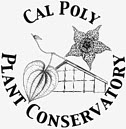Biology Professor and Students Discover
Record Eucalyptus Tree in Cal Poly Canyon
Record Eucalyptus Tree in Cal Poly Canyon
SAN LUIS OBISPO -- California Polytechnic State University's Biology Professor Matt Ritter and three of his students recently discovered what is thought to be the tallest Karri Eucalyptus (Eucalyptus diversicolor) tree in North America.
Ritter, a biology professor and head of the Cal Poly Plant Conservatory, spotted the massive tree in Poly Canyon in 2005. But it wasn’t until late November 2007 that he and graduate students Jenn Yost and Chris Wassenberg, along with undergraduate Justin Bence, were able to climb to the top of the giant tree to measure it.
Using ropes and harnesses, the four researchers were able to get an accurate measurement of the tree’s height by dropping a line to the ground from the upper canopy.
They recorded the tree at a height of 49 meters (154 feet), a diameter over 2 meters (7 feet), with a 23 meter wide crown (75 feet) .
Ritter submitted the data to the California Registry of Big Trees, part of a national forestry database. The tree at Brizzolara Creek has been accepted as the tallest Karri Eucalyptus tree on record in North America -- almost 100 feet taller than the previous North American record holder, a San Clemente tree 59 feet tall.
"In my research on California Eucalyptus ecology I've looked for all the specimens of E. diversicolor and other species planted throughout the state, Arizona, Hawaii and Florida," Ritter added. "This is by far the oldest and largest specimen."
Like other types of Eucalyptus trees, the Karri is native to Australia. There, it is found only in the towering forests south of Perth, on the southwestern tip of the continent, and is a relatively uncommon species in the U.S. according to Ritter.
The record tree, estimated to be between 80 and 100 years old, can be found in the bottom of Brizzolara Creek in Poly Canyon, the only Karri in a stand of Tasmanian Blue Gums.
 Nominate outstanding specimens to the California Registry of Big Trees
Nominate outstanding specimens to the California Registry of Big TreesMore Giant Karri eucalypts around this site
More Eucalyptus Giants around this site
More Eucalyptus Giants around this site
- Eucalyptus paulistana: The Brazilian Giant
- Eucalyptus globulus: Giant Heritage Trees
- Eucalyptus Giants: The Fat Guys at Both Sides of the World
- Grandpa, the Giant Eucalyptus... in video (video)
- King Regnans: Attenborough's Eucalyptus Giants (video)
- Giant Trees: Eucalyptus & friends (video)
- Eucalyptus: coastal rainforests in Galicia (Spain)
Subscribe to receive EUCALYPTOLOGICS via RSS






Hola,
ReplyDeleteSupongo que ya lo has leido pero por si acaso...
un arbol de más de treinta toneladas
Gracias igualmente!
ReplyDeletePena no avisaron antes de cortar ese de las 30 toneladas, para fotografiarlo, medirlo y recolectar semilla.
El microclima de esa zona es muy benigno, produce ejemplares gigantes con facilidad :-)
Aún así no hay muchos como el de Celestino... todavía.
Posted by Ed A. z.7a Alexandria VA on 1/24/2008, 6:58 pm, in reply to "Giant Karri Eucalyptus discovered in California"
ReplyDeleteThanks for sharing that story. It is amazing that no one ever noticed that tree at all or knew it was there in one hundred years! I guess that perhaps because the genus has so many species that it is hard to know them all or tell the difference between them. This would never have happened with a native tree species.
Posted by Gus on 1/25/2008, 3:39 am, in reply to "Re: Giant Karri Eucalyptus discovered in California"
ReplyDeleteNative species do matter. And it is good to be aware of champion trees of these no matter where. But as you well say, exotics species do also exist. And champion specimens are as valuable as heritage trees as the former. Living proof of the footprints of our ancestor plant nuts! That is why I always say the "please remove that weed" fever some have in California can be misguided sometimes. If this particular tree had been removed for some "restore the native ecosystem" project, North America would have lost its finest specimen of karri. Native species have the advantage of having natural replacement in many cases. But some of the exotic ones cannot be replaced.
You are right about eucalypts being a bit of difficult to tell apart. But as we see, not every tree of this type in California is a Tasmanian Blue Gum. Paying attention sometimes leads to amazing discoveries as the one of Dr. Ritter.